We found some beautiful French postcards of the 1920s with exquisite photos of stage- and film actors by 'Wyndham'. Some of the sepia-coloured postcards were published by Wyndham Ed., probably the photographer himself - or maybe herself? Was 'Wyndham' the British society portrait photographer Olivia Wyndham (1897-1967)? And if so, who was this talented bohemian who was so important for the 'bright young things' of the 1920s, but whose photos are now mostly neglected?

French postcard by Cinémagazine-Edition, no. 35. Photo: Wyndham.
French film actress Suzanne Bianchetti (1889-1936) was one of France's most loved and respected actresses of her time. She played Marie Antoinette in Abel Gance's epic Napoléon (1927) and worked with many other great names of the silent cinema. After her death the Prix Suzanne Bianchetti was created in her memory, an annual French award to be given to the most promising young actress.
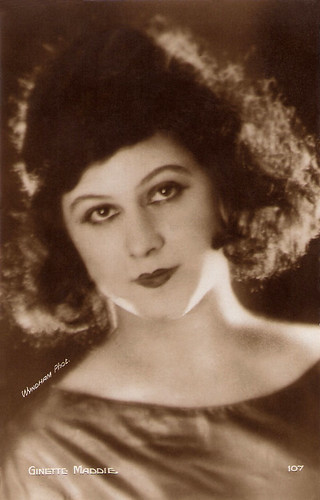
French postcard by Editions Cinémagazine, no. 107. Photo: Wyndham.
Ginette Maddie (1898-1980) was a French actress who acted in French and German silent films. She started in 1922 opposite Claude Merelle in Le diamant noir (André Hugon). Maddie had female leads in Sarati le terrible (René Hervil, Louis Mercanton, 1923), the comedy Les héritiers de l'oncle James (Alfred Machin, Henry Wulschleger, 1924), and La lueur dans les ténèbres ( Maurice Charmeroy, 1928). In the early sound era, Maddie only acted in two films.

French postcard by Editions Cinémagazine, no. 115. Photo: Wyndham.
Eric Barclay (1894–1938) was a Swedish film actor. Barclay became a prominent actor in French silent films of the early 1920s, often working with director Jacques de Baroncelli. He also appeared in German and British films and those of his native Sweden.
Olivia Wyndham was a high-class rebel. She was born in 1897 or 1898 (the sources differ) as Olivia Madeline Grace Mary Wyndham into a wealthy family of often aesthetically-inclined aristocrats, but she was also a bohemian, a lesbian, and a long-time user of heroin and cocaine.
The daughter of Colonel Guy Percy Wyndham and his wife Edwina Virginia Joanna, daughter of Rev. Frederick Fitzpatrick, Olivia was the great-great-granddaughter of the 3rd Earl of Egremont and great-granddaughter of the 1st Baron Leconfield. She was also the sister of millionaire Richard 'Dick' Wyndham, cousin of David and Stephen Tennant, and a distant relative of Oscar Wilde.
Olivia spent much of her childhood in various country houses that have achieved a fame of their own. Her younger nephew (or half-brother - the sources differ) was the journalist, editor, and writer Francis Wyndham, who was the literary executor to Jean Rhys. Francis later wrote with deep affection and humour about his eccentric aunt (or half-sister) in his roman à clef 'Mrs. Henderson and Other Stories' (1985).
Like many women of her background she had worked, during the War, for the Voluntary Aid Detachment (VAD) in France. She was not prepared to return home and 'settle down'. Having tried her hand at a dance school, she moved into the newly fashionable area of photography. In Paris, she found work in the world of stage and cinema. All the postcards in this post were produced in the early 1920s. But are they hers? On the web, there are no sources that connect the pictures or postcards with Olivia Wyndham.
In 1925 she opened a portrait studio, M Studio in Fitzroy Square in London, with American photographer Curtis Moffat. He was a wealthy American, married to the legendary Iris Tree. He had been studying photography in Paris with Man Ray. Both Moffat and Wyndham used their considerable social connections to entice sitters to showcase the 'new' look.
In their London studio, they produced stylish photographic portraits of leading society and art figures, known colloquially as the 'bright young things'. According to Sir Frederick Ashton, she was the real 'instigator' of the whole scene. She brought together many of the different cliques that together constitute the Bright Young People. Regular subjects for Moffat and Wyndham were Edith, Osbert and Sacheverell Sitwell, Tallulah Bankhead and Cecil Beaton. In June 1927, they held an exhibition.
Wyndham was by this time located at 19 King’s Road. This address became the main meeting ground for Olivia’s lesbian friends and a number of young artists and dancers associated with Chelsea Art College, including young photographer Barbara Ker-Seymer. By 1929, part of 19 King’s Road had been turned into a studio. She fell in love with the African American actress Edna Thomas when Thomas performed with the African American revue 'The Blackbirds' in London. Olivia followed her from London to New York, where Thomas's successful salon was the centre of the Harlem Renaissance. Barbara Ker-Seymer took over Wyndham's studio at 19 King’s Road.
To stay in the United States, Wyndham married Howland Spencer in May 1930. They divorced in 1931. His blackmail threats about her lesbian relationship with Thomas were squelched by Wyndham's scandal-averse father. Olivia and Edna would have a lifelong relationship. Edna became famous for her interpretation of Lady Macbeth in Orson Welles’ stage debut in 1934. They lived in a ménage à trois with Edna's husband, Lloyd Thomas. In the 1930s, Wyndham was painted by the artist Joseph Delaney.
During World War II, Olivia Wyndham served in the Women's Army Corps as an embedded photographer in the Pacific. The rest of her career, she spent with the U.S. Veterans Administration.
Maurice Bottomley at his blog Cocktails with Elvira: "nothing about her, including rampant promiscuity and the odd punch-up, stopped people liking Olivia. She was, nearly everyone said, 'generous'. Not just with money, in fact, she was by no means wealthy thanks to a cock-up over inheritance, but with her time and friendship. Quick-tempered and full of flaws herself, she was able to overlook failings in others. "
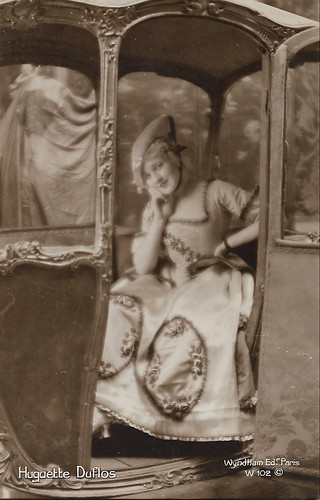
French postcard by Wyndham Ed., Paris, no. W 102.
Actress Huguette Duflos (1887-1982) was a leading lady of the French silent cinema of the 1920s.

French postcard by Wyndham Ed., Paris, no. W 103. Photo: Sylvain in Molière's play Tartufe.
Eugène Sylvain (1851-1930), better known as Sylvain and Silvain, was a prominent French stage actor, though he is best remembered as the evil bishop Cauchon in Carl Dreyer’s silent masterpiece La passion de Jeanne d’Arc (1928).
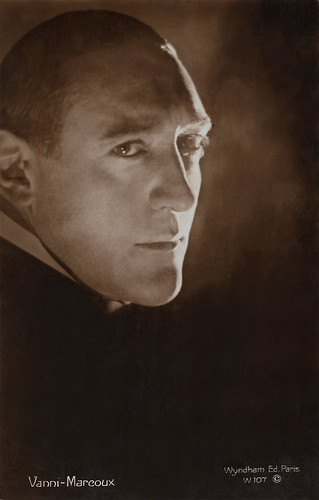
French postcard by Wyndham Ed., Paris, no. W 107. Vanni Marcoux's name was also written with a hyphen.
Jean-Émile Diogène Marcoux (1877–1962) was a French operatic bass-baritone, known professionally as Vanni Marcoux (aka Vanni-Marcoux). He was renowned as one of the most memorable singing-actors of the 20th century. Vanni Marcoux only acted in 4 films, but everytime in a leading role: he was Faust in Don Juan et Faust (Marcel L'Herbier, 1922), Maurice Ferrioul in the Franco-British coproduction The Scandal (Arthur Rooke, 1923), Charles le Téméraire in Le Miracle des Loups (Raymond Bernard, 1924), and as Vitalis in Sans famille (Marc Allégret, 1934).

French postcard by Wyndham Ed. Paris, no. W 108.
Véra Sergine (1884-1946) was a popular French stage actress between the 1910s and 1930s, who was also active in French silent cinema of the 1910s. She was first married to Pierre Renoir, then had a long relationship with Henri Rollan. She is also the mother of Claude Renoir.
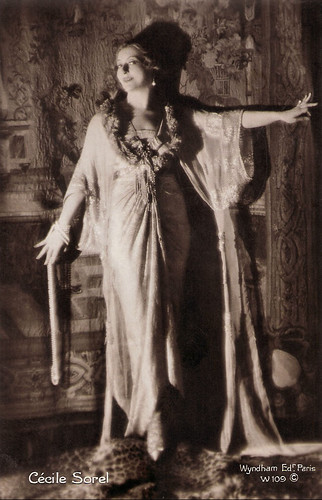
French postcard by Wyndham Ed., no. W 109.
Legendary actress Cécile Sorel (1873-1966) was the ‘queen of the French stage’ during the Belle Epoque, the period between the Paris Exposition of 1900 and the First World War. Her public appearances, often in extravagant costumes, created a sensation. During her long life, she played in five films.

French postcard by Editions FILMA, Paris, no. 109. Photo: Wyndham.
French film actress Suzanne Bianchetti (1889-1936) was one of France's most loved and respected actresses of her time. She played Marie Antoinette in Abel Gance's epic Napoléon (1927) and worked with many other great names of the silent cinema. After her death the Prix Suzanne Bianchetti was created in her memory, an annual French award to be given to the most promising young actress.
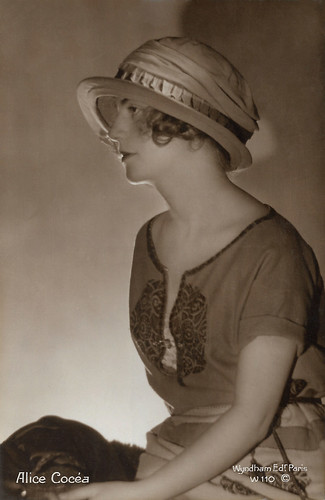
French postcard by Wyndham Ed., Paris, no. W 110.
Alice Cocéa (1899-1970) was a Romanian-born French stage and screen actress. who peaked in the early 1930s French cinema.

French postcard. Wyndham, Ed., Paris.
Ginette Maddie (1898-1980) was a French actress who acted in French and German silent films. She started in 1922 opposite Claude Merelle in Le diamant noir (André Hugon). Maddie had female leads in Sarati le terrible (René Hervil, Louis Mercanton, 1923), the comedy Les héritiers de l'oncle James (Alfred Machin, Henry Wulschleger, 1924), and La lueur dans les ténèbres ( Maurice Charmeroy, 1928). In the early sound era, Maddie only acted in two films.
Sources: Christopher Hallam (White Drug Cultures and Regulation in London, 1916–1960), David Mellor (Modern British photography, 1919-1939), Lisa Cohen (All We Know: Three Lives), Maurice Bottomley (Cocktails With Elvira), and Wikipedia.

French postcard by Cinémagazine-Edition, no. 35. Photo: Wyndham.
French film actress Suzanne Bianchetti (1889-1936) was one of France's most loved and respected actresses of her time. She played Marie Antoinette in Abel Gance's epic Napoléon (1927) and worked with many other great names of the silent cinema. After her death the Prix Suzanne Bianchetti was created in her memory, an annual French award to be given to the most promising young actress.

French postcard by Editions Cinémagazine, no. 107. Photo: Wyndham.
Ginette Maddie (1898-1980) was a French actress who acted in French and German silent films. She started in 1922 opposite Claude Merelle in Le diamant noir (André Hugon). Maddie had female leads in Sarati le terrible (René Hervil, Louis Mercanton, 1923), the comedy Les héritiers de l'oncle James (Alfred Machin, Henry Wulschleger, 1924), and La lueur dans les ténèbres ( Maurice Charmeroy, 1928). In the early sound era, Maddie only acted in two films.

French postcard by Editions Cinémagazine, no. 115. Photo: Wyndham.
Eric Barclay (1894–1938) was a Swedish film actor. Barclay became a prominent actor in French silent films of the early 1920s, often working with director Jacques de Baroncelli. He also appeared in German and British films and those of his native Sweden.
Who was Olivia Wyndham?
Olivia Wyndham was a high-class rebel. She was born in 1897 or 1898 (the sources differ) as Olivia Madeline Grace Mary Wyndham into a wealthy family of often aesthetically-inclined aristocrats, but she was also a bohemian, a lesbian, and a long-time user of heroin and cocaine.
The daughter of Colonel Guy Percy Wyndham and his wife Edwina Virginia Joanna, daughter of Rev. Frederick Fitzpatrick, Olivia was the great-great-granddaughter of the 3rd Earl of Egremont and great-granddaughter of the 1st Baron Leconfield. She was also the sister of millionaire Richard 'Dick' Wyndham, cousin of David and Stephen Tennant, and a distant relative of Oscar Wilde.
Olivia spent much of her childhood in various country houses that have achieved a fame of their own. Her younger nephew (or half-brother - the sources differ) was the journalist, editor, and writer Francis Wyndham, who was the literary executor to Jean Rhys. Francis later wrote with deep affection and humour about his eccentric aunt (or half-sister) in his roman à clef 'Mrs. Henderson and Other Stories' (1985).
Like many women of her background she had worked, during the War, for the Voluntary Aid Detachment (VAD) in France. She was not prepared to return home and 'settle down'. Having tried her hand at a dance school, she moved into the newly fashionable area of photography. In Paris, she found work in the world of stage and cinema. All the postcards in this post were produced in the early 1920s. But are they hers? On the web, there are no sources that connect the pictures or postcards with Olivia Wyndham.
In 1925 she opened a portrait studio, M Studio in Fitzroy Square in London, with American photographer Curtis Moffat. He was a wealthy American, married to the legendary Iris Tree. He had been studying photography in Paris with Man Ray. Both Moffat and Wyndham used their considerable social connections to entice sitters to showcase the 'new' look.
In their London studio, they produced stylish photographic portraits of leading society and art figures, known colloquially as the 'bright young things'. According to Sir Frederick Ashton, she was the real 'instigator' of the whole scene. She brought together many of the different cliques that together constitute the Bright Young People. Regular subjects for Moffat and Wyndham were Edith, Osbert and Sacheverell Sitwell, Tallulah Bankhead and Cecil Beaton. In June 1927, they held an exhibition.
Wyndham was by this time located at 19 King’s Road. This address became the main meeting ground for Olivia’s lesbian friends and a number of young artists and dancers associated with Chelsea Art College, including young photographer Barbara Ker-Seymer. By 1929, part of 19 King’s Road had been turned into a studio. She fell in love with the African American actress Edna Thomas when Thomas performed with the African American revue 'The Blackbirds' in London. Olivia followed her from London to New York, where Thomas's successful salon was the centre of the Harlem Renaissance. Barbara Ker-Seymer took over Wyndham's studio at 19 King’s Road.
To stay in the United States, Wyndham married Howland Spencer in May 1930. They divorced in 1931. His blackmail threats about her lesbian relationship with Thomas were squelched by Wyndham's scandal-averse father. Olivia and Edna would have a lifelong relationship. Edna became famous for her interpretation of Lady Macbeth in Orson Welles’ stage debut in 1934. They lived in a ménage à trois with Edna's husband, Lloyd Thomas. In the 1930s, Wyndham was painted by the artist Joseph Delaney.
During World War II, Olivia Wyndham served in the Women's Army Corps as an embedded photographer in the Pacific. The rest of her career, she spent with the U.S. Veterans Administration.
Maurice Bottomley at his blog Cocktails with Elvira: "nothing about her, including rampant promiscuity and the odd punch-up, stopped people liking Olivia. She was, nearly everyone said, 'generous'. Not just with money, in fact, she was by no means wealthy thanks to a cock-up over inheritance, but with her time and friendship. Quick-tempered and full of flaws herself, she was able to overlook failings in others. "

French postcard by Wyndham Ed., Paris, no. W 102.
Actress Huguette Duflos (1887-1982) was a leading lady of the French silent cinema of the 1920s.

French postcard by Wyndham Ed., Paris, no. W 103. Photo: Sylvain in Molière's play Tartufe.
Eugène Sylvain (1851-1930), better known as Sylvain and Silvain, was a prominent French stage actor, though he is best remembered as the evil bishop Cauchon in Carl Dreyer’s silent masterpiece La passion de Jeanne d’Arc (1928).

French postcard by Wyndham Ed., Paris, no. W 107. Vanni Marcoux's name was also written with a hyphen.
Jean-Émile Diogène Marcoux (1877–1962) was a French operatic bass-baritone, known professionally as Vanni Marcoux (aka Vanni-Marcoux). He was renowned as one of the most memorable singing-actors of the 20th century. Vanni Marcoux only acted in 4 films, but everytime in a leading role: he was Faust in Don Juan et Faust (Marcel L'Herbier, 1922), Maurice Ferrioul in the Franco-British coproduction The Scandal (Arthur Rooke, 1923), Charles le Téméraire in Le Miracle des Loups (Raymond Bernard, 1924), and as Vitalis in Sans famille (Marc Allégret, 1934).

French postcard by Wyndham Ed. Paris, no. W 108.
Véra Sergine (1884-1946) was a popular French stage actress between the 1910s and 1930s, who was also active in French silent cinema of the 1910s. She was first married to Pierre Renoir, then had a long relationship with Henri Rollan. She is also the mother of Claude Renoir.

French postcard by Wyndham Ed., no. W 109.
Legendary actress Cécile Sorel (1873-1966) was the ‘queen of the French stage’ during the Belle Epoque, the period between the Paris Exposition of 1900 and the First World War. Her public appearances, often in extravagant costumes, created a sensation. During her long life, she played in five films.

French postcard by Editions FILMA, Paris, no. 109. Photo: Wyndham.
French film actress Suzanne Bianchetti (1889-1936) was one of France's most loved and respected actresses of her time. She played Marie Antoinette in Abel Gance's epic Napoléon (1927) and worked with many other great names of the silent cinema. After her death the Prix Suzanne Bianchetti was created in her memory, an annual French award to be given to the most promising young actress.

French postcard by Wyndham Ed., Paris, no. W 110.
Alice Cocéa (1899-1970) was a Romanian-born French stage and screen actress. who peaked in the early 1930s French cinema.

French postcard. Wyndham, Ed., Paris.
Ginette Maddie (1898-1980) was a French actress who acted in French and German silent films. She started in 1922 opposite Claude Merelle in Le diamant noir (André Hugon). Maddie had female leads in Sarati le terrible (René Hervil, Louis Mercanton, 1923), the comedy Les héritiers de l'oncle James (Alfred Machin, Henry Wulschleger, 1924), and La lueur dans les ténèbres ( Maurice Charmeroy, 1928). In the early sound era, Maddie only acted in two films.
Sources: Christopher Hallam (White Drug Cultures and Regulation in London, 1916–1960), David Mellor (Modern British photography, 1919-1939), Lisa Cohen (All We Know: Three Lives), Maurice Bottomley (Cocktails With Elvira), and Wikipedia.
No comments:
Post a Comment